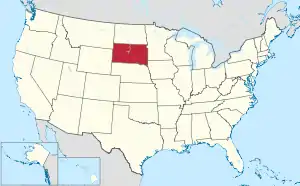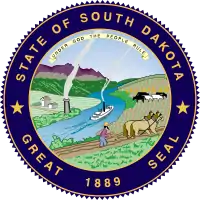Turner County, South Dakota
Turner County is a county in the U.S. state of South Dakota. As of the 2010 census, the population was 8,347.[1] Its county seat is Parker.[2] The county was established in 1871, and was named for Dakota Territory official John W. Turner.[3]
Turner County | |
|---|---|
 Turner County Courthouse in Parker | |
 Location within the U.S. state of South Dakota | |
 South Dakota's location within the U.S. | |
| Coordinates: 43°19′N 97°09′W | |
| Country | |
| State | |
| Founded | 1871 |
| Named for | John W. Turner |
| Seat | Parker |
| Largest city | Parker |
| Area | |
| • Total | 618 sq mi (1,600 km2) |
| • Land | 617 sq mi (1,600 km2) |
| • Water | 0.6 sq mi (2 km2) 0.1% |
| Population (2010) | |
| • Total | 8,347 |
| • Estimate (2018) | 8,424 |
| • Density | 14/sq mi (5.2/km2) |
| Time zone | UTC−6 (Central) |
| • Summer (DST) | UTC−5 (CDT) |
| Congressional district | At-large |
| Website | turner |
Turner County is a part of the Sioux Falls, SD Metropolitan Statistical Area.
Geography
The terrain of Turner County consists of rolling hills, carved by gullies and drainages. The area is largely devoted to agriculture.[4] The terrain slopes to the south and east; its highest point is along its west boundary line, at 1,578' (481m) ASL.[5] The county has a total area of 618 square miles (1,600 km2), of which 617 square miles (1,600 km2) is land and 0.6 square miles (1.6 km2) (0.1%) is water.[6]
Major highways
 U.S. Highway 18
U.S. Highway 18 U.S. Highway 81
U.S. Highway 81 South Dakota Highway 19
South Dakota Highway 19 South Dakota Highway 44
South Dakota Highway 44 South Dakota Highway 46
South Dakota Highway 46- South Dakota Highway 19A
Adjacent counties
- Minnehaha County - northeast
- Lincoln County - east
- Clay County - southeast
- Yankton County - southwest
- Hutchinson County - west
- McCook County - northwest
Protected areas[4]
- Miller Waterfowl Production Area
- Peterson Waterfowl Production Area
- Plucker Waterfowl Production Area
Lakes[4]
- Mud Lake
- Swan Lake
Demographics
| Historical population | |||
|---|---|---|---|
| Census | Pop. | %± | |
| 1880 | 5,320 | — | |
| 1890 | 10,256 | 92.8% | |
| 1900 | 13,175 | 28.5% | |
| 1910 | 13,840 | 5.0% | |
| 1920 | 14,871 | 7.4% | |
| 1930 | 14,891 | 0.1% | |
| 1940 | 13,270 | −10.9% | |
| 1950 | 12,100 | −8.8% | |
| 1960 | 11,159 | −7.8% | |
| 1970 | 9,872 | −11.5% | |
| 1980 | 9,255 | −6.2% | |
| 1990 | 8,576 | −7.3% | |
| 2000 | 8,849 | 3.2% | |
| 2010 | 8,347 | −5.7% | |
| 2019 (est.) | 8,384 | [7] | 0.4% |
| U.S. Decennial Census[8] 1790-1960[9] 1900-1990[10] 1990-2000[11] 2010-2018[1] | |||

2000 census
As of the 2000 United States Census,[12] there were 8,849 people, 3,510 households, and 2,478 families in the county. The population density was 14 people per square mile (6/km2). There were 3,852 housing units at an average density of 6 per square mile (2/km2). The racial makeup of the county was 98.86% White, 0.15% Black or African American, 0.27% Native American, 0.17% Asian, 0.12% from other races, and 0.43% from two or more races. 0.41% of the population were Hispanic or Latino of any race.
There were 3,510 households, out of which 31.60% had children under the age of 18 living with them, 61.90% were married couples living together, 5.60% had a female householder with no husband present, and 29.40% were non-families. 26.50% of all households were made up of individuals, and 14.80% had someone living alone who was 65 years of age or older. The average household size was 2.46 and the average family size was 2.99.
The county population contained 25.80% under the age of 18, 6.20% from 18 to 24, 24.80% from 25 to 44, 22.80% from 45 to 64, and 20.40% who were 65 years of age or older. The median age was 40 years. For every 100 females, there were 97.20 males. For every 100 females age 18 and over, there were 93.90 males.
The median income for a household in the county was $36,059, and the median income for a family was $42,704. Males had a median income of $28,833 versus $20,075 for females. The per capita income for the county was $17,343. About 5.70% of families and 7.20% of the population were below the poverty line, including 6.30% of those under age 18 and 11.30% of those age 65 or over.
2010 census
As of the 2010 United States Census, there were 8,347 people, 3,452 households, and 2,363 families in the county.[13] The population density was 13.5 inhabitants per square mile (5.2/km2). There were 3,939 housing units at an average density of 6.4 per square mile (2.5/km2).[14] The racial makeup of the county was 97.5% white, 0.8% American Indian, 0.2% black or African American, 0.2% Asian, 0.3% from other races, and 0.9% from two or more races. Those of Hispanic or Latino origin made up 1.3% of the population.[13] In terms of ancestry, 47.7% were German, 18.4% were Norwegian, 11.3% were Danish, 9.4% were Irish, 8.5% were Dutch, and 2.7% were American.[15]
Of the 3,452 households, 29.0% had children under the age of 18 living with them, 58.7% were married couples living together, 5.9% had a female householder with no husband present, 31.5% were non-families, and 27.4% of all households were made up of individuals. The average household size was 2.37 and the average family size was 2.87. The median age was 43.7 years.[13]
The median income for a household in the county was $48,068 and the median income for a family was $57,881. Males had a median income of $37,622 versus $27,459 for females. The per capita income for the county was $22,871. About 4.7% of families and 7.7% of the population were below the poverty line, including 8.9% of those under age 18 and 9.1% of those age 65 or over.[16]
Culture
Turner County hosts the oldest county fair in the Dakotas. It held its first fair on October 13–16, 1880. The Turner County Agriculture Society was organized in March 1880. Its stated purpose was to showcase the agricultural successes of the new county. The fair was held at various locations over the years, but has been at its current location east of Parker for well over half a century.[17]
Communities
Towns
Townships
- Brothersfield
- Centerville
- Childstown
- Daneville
- Dolton
- Germantown
- Home
- Hurley
- Marion
- Middleton
- Monroe
- Norway
- Parker
- Rosefield
- Salem
- Spring Valley
- Swan Lake
- Turner
Politics
Turner County voters are reliably Republican. In no national election since 1932 has the county selected the Democratic Party candidate.
| Year | Republican | Democratic | Third parties |
|---|---|---|---|
| 2020 | 72.3% 3,290 | 25.0% 1,139 | 2.6% 119 |
| 2016 | 70.8% 2,937 | 23.2% 961 | 6.1% 252 |
| 2012 | 64.5% 2,715 | 33.5% 1,411 | 2.0% 84 |
| 2008 | 58.3% 2,538 | 38.6% 1,681 | 3.1% 133 |
| 2004 | 63.8% 3,084 | 34.1% 1,646 | 2.2% 104 |
| 2000 | 62.8% 2,514 | 35.3% 1,414 | 1.9% 76 |
| 1996 | 48.6% 1,970 | 41.5% 1,682 | 9.9% 399 |
| 1992 | 44.4% 1,906 | 35.1% 1,507 | 20.4% 877 |
| 1988 | 57.5% 2,436 | 42.0% 1,780 | 0.5% 23 |
| 1984 | 67.2% 3,086 | 32.4% 1,486 | 0.4% 20 |
| 1980 | 66.4% 3,343 | 27.2% 1,369 | 6.4% 320 |
| 1976 | 58.3% 2,694 | 41.3% 1,906 | 0.4% 18 |
| 1972 | 60.0% 3,007 | 39.8% 1,993 | 0.2% 10 |
| 1968 | 67.6% 3,246 | 28.1% 1,350 | 4.3% 205 |
| 1964 | 56.6% 2,846 | 43.4% 2,184 | |
| 1960 | 72.7% 4,120 | 27.3% 1,547 | |
| 1956 | 70.9% 4,096 | 29.1% 1,682 | |
| 1952 | 82.4% 4,604 | 17.6% 984 | |
| 1948 | 66.3% 3,048 | 32.9% 1,514 | 0.8% 38 |
| 1944 | 73.1% 3,549 | 26.9% 1,304 | |
| 1940 | 72.4% 4,644 | 27.6% 1,774 | |
| 1936 | 49.3% 3,214 | 44.8% 2,923 | 6.0% 389 |
| 1932 | 40.2% 2,172 | 58.7% 3,170 | 1.2% 63 |
| 1928 | 70.7% 3,362 | 29.0% 1,380 | 0.4% 17 |
| 1924 | 45.9% 1,708 | 7.7% 285 | 46.4% 1,726 |
| 1920 | 67.6% 2,703 | 15.1% 604 | 17.3% 692 |
| 1916 | 56.9% 1,573 | 41.0% 1,134 | 2.0% 56 |
| 1912 | 0.0% 0 | 34.7% 906 | 65.3% 1,707 |
| 1908 | 66.2% 1,792 | 29.3% 793 | 4.5% 123 |
| 1904 | 79.1% 2,395 | 17.2% 521 | 3.7% 113 |
| 1900 | 68.2% 1,977 | 30.1% 871 | 1.7% 50 |
| 1896 | 62.5% 1,616 | 36.7% 950 | 0.8% 21 |
| 1892 | 56.7% 1,108 | 21.9% 429 | 21.4% 418 |
External links
References
- "State & County QuickFacts". United States Census Bureau. Retrieved November 28, 2013.
- "Find a County". National Association of Counties. Retrieved June 7, 2011.
- Hellmann, Paul T. (May 13, 2013). Historical Gazetteer of the United States. Routledge. p. 994. ISBN 978-1135948597. Retrieved November 30, 2013.
- Turner County SD Google Maps (accessed 8 February 2019)
- ""Find at Altitude" Google Maps (accessed 8 February 2019)". Archived from the original on May 21, 2019. Retrieved February 9, 2019.
- "2010 Census Gazetteer Files". US Census Bureau. August 22, 2012. Retrieved March 28, 2015.
- "Annual Estimates of the Resident Population for Counties: April 1, 2010 to July 1, 2019". Retrieved April 10, 2020.
- "US Decennial Census". US Census Bureau. Retrieved March 28, 2015.
- "Historical Census Browser". University of Virginia Library. Retrieved March 28, 2015.
- Forstall, Richard L., ed. (March 27, 1995). "Population of Counties by Decennial Census: 1900 to 1990". US Census Bureau. Retrieved March 28, 2015.
- "Census 2000 PHC-T-4. Ranking Tables for Counties: 1990 and 2000" (PDF). US Census Bureau. April 2, 2001. Retrieved March 28, 2015.
- "U.S. Census website". US Census Bureau. Retrieved May 14, 2011.
- "Profile of General Population and Housing Characteristics: 2010 Demographic Profile Data". US Census Bureau. Archived from the original on February 13, 2020. Retrieved March 12, 2016.
- "Population, Housing Units, Area, and Density: 2010 - County". US Census Bureau. Archived from the original on February 13, 2020. Retrieved March 12, 2016.
- "Selected Social Characteristics in the US – 2006-2010 American Community Survey 5-Year Estimates". US Census Bureau. Archived from the original on February 13, 2020. Retrieved March 12, 2016.
- "Selected Economic Characteristics – 2006-2010 American Community Survey 5-Year Estimates". US Census Bureau. Archived from the original on February 13, 2020. Retrieved March 12, 2016.
- "Turner County Fair". Retrieved January 23, 2008.
- Leip, David. "Atlas of US Presidential Elections". uselectionatlas.org. Retrieved April 15, 2018.
